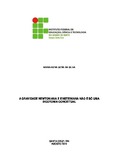| dc.creator | Silva, Maria Adna Sena da | |
| dc.date.accessioned | 2019-12-26T17:27:12Z | |
| dc.date.available | 2019-12-26T17:27:12Z | |
| dc.date.issued | 2019-08-12 | |
| dc.identifier.citation | “O segredo inteiro de uma vida de sucesso é encontrar qual o nosso destino e então o concretizar.”
Henry Ford | pt_BR |
| dc.identifier.uri | http://memoria.ifrn.edu.br/handle/1044/1732 | |
| dc.description.abstract | One of nature's most notorious and simple observations is that if you hold a stone on your hand and drop it, the stone falls. Why does it happen? The answer is: - Gravity. It was Isaac Newton (1643-1727), one of the most brilliant scientists who suggested that a mysterious force, the force of gravity by which all things are brought toward. He also said that this same force is responsible for maintaining the planets motion and the moon orbiting the sun. Although Newton's theory has had extraordinary success, explaining many facts and even predicting new facts, it is not a completely correct theory of gravitation. It fails explaining a large number of phenomena, and some of its failures made possible that Einstein propose a new theory, the Theory of General Relativity. The main target of this work is to analyze a little more deeply the concept of gravity using Classical (Newtonian) and Modern (Einsteinian) Physics. This analysis will be conducted by a Potentially Significant Teaching Unit (PSTU) based on David Ausubel's Theory of Significant Learning. The PSTU was elaborated according to the criteria established by MOREIRA (2011). This unit will be useful to assist physics teachers who want to expose the gravity concepts through a more reflective and less mathematical bias. At this way, besides introducing the study of some concepts that are part of the General Relativity Theory, the PSTU will allow students to understand the limits of Newton's Theory of Gravitation and the radical changes in the understanding and in the interpretation proposed by General Theory of Relativity for the conception of time and space. | pt_BR |
| dc.language | por | pt_BR |
| dc.publisher | Instituto Federal de Educação, Ciência e Tecnologia do Rio Grande do Norte | pt_BR |
| dc.rights | Acesso Aberto | pt_BR |
| dc.subject | Física - Gravidade | pt_BR |
| dc.subject | Gravitação universal | pt_BR |
| dc.subject | Relatividade geral | pt_BR |
| dc.subject | Unidade de ensino potencialmente significativa (UEPS) | pt_BR |
| dc.subject | Ensino de física | pt_BR |
| dc.title | A gravidade newtoniana e einsteiniana não é só uma dicotomia conceitual | pt_BR |
| dc.title.alternative | Newtonian and einsteinian gravity are not only a conceptual dichotomy | pt_BR |
| dc.type | Trabalho de Conclusão de Curso | pt_BR |
| dc.creator.Lattes | http://buscatextual.cnpq.br/buscatextual/visualizacv.do?id=K2170761H1&tokenCaptchar=03AOLTBLRAAsRuXwPCA8Y6JClBx8n3gDwk7pArQFjQ5BAoF3s1imoT1QnRhMkCIV1vvWMawxqbxQ-8AJbqXeg_QGQbqNa7bHFi7EkYyiXoYy-04rrt9DvthgoBd8l7iqg3d8rCK21ulHKlWj89FR4NIN8jSXBEFPYPLlohGFp2hfJDbyi1IdneTi_6eqtX3xsXWF5_vtNOPfxwAmTktViSpOvy7NUmlCMrypEv1HPoHU081x2c7ecsO3vRDw0WyMJv16A5hO--jlodto-Fxl5_QTafOwdBIqz15gzQ6HRe8L30b3ua9NIIwMHQA4tzRPElcvglhbw0i_OWz9u3yEwUfxmcWn_v7Ho9-iMybTzbjtr2ucghU03y7lo2O-9lYxDvQl70f2Nf1lkQwYwz2B200MKKozNyXNy0ZhgyyOVEYo2yzaTxzhUWUyYYrEnpSR49ifTM8U5YAnMRD6UyVGmpd81NdhFIoOihgg | pt_BR |
| dc.contributor.advisor1 | Lima, Geogenes Melo de | |
| dc.contributor.advisor1Lattes | http://buscatextual.cnpq.br/buscatextual/visualizacv.do?id=K4887288Z8&tokenCaptchar=03AOLTBLSFYBsdODsEocUlITwW9-N4uktc8t15Taic9Ou4jWBM_SPlOdK-2boFhy5eupPuObFnkVSynj-8XbygGw2OLX67UFMzt0oGQc1VzZTgLKpthhbsLzHx9_SsL5iO8bhTcWtJISrljZeX2ygL2fk0ejLcMTNR9db2cpxAUGJnVg59BzE8oVlCcroOZLUHClEE-bRKsE8aYkouPYIWbezspHzmIA5faoN9QVG991MoOIIEtqGhv-U625-eXNj8bCylHMsiLgUI85UmWQUYmZ8yvnIh2REnreCkI0CGJm3FFjc3lvAI9y6GyS23HpBP4o5MeMjRKgX3cUQW0RcaU0vwnMPRbP601PqlXg8u7ddKMnJIg5YLJnrL-lB54n2KRj9WOPhv159a3kqqENBkL7iSPyLkgZVdHxr7kfsqrMzhmyxFGdtLZFbpav79a7BFMjxuY0qHiOInBJEhvJOUfyznOV0SKpXy5w | pt_BR |
| dc.contributor.referee1 | Sousa, Roney Roberto de Melo | |
| dc.contributor.referee1Lattes | http://buscatextual.cnpq.br/buscatextual/visualizacv.do?id=K4893934J3&tokenCaptchar=03AOLTBLQBnoe8YHrxjCR6XZkkihOkrKOPjmf3TpfDKklQD40etRipficKSjqHH30e-OKNQEGcoUXgN9fLDKnxMNDiqgMRy0w5CYrv9rBNv8pOcchYf3U3Fs5hmJw-RlSgPpmSTeh441cckEYo3myeMKXsb9DTfeOwR0q3P5HuLCDKsUXdRrHeNHgzh6wkTxgr-QKxVMVKVu5ftZ8W0MOHmGibYacbqeTclJt232STsST3XOsMJMqjUFld61PRzltCcmaDA037dbYmJ6Z_htVPSu7gMzdNp62Y94b17npYfLbiwdhvD1twuwWisElhvM3uBAiDCJ83JzShk-5xLf3aNzOKMViNu9N7ao9bk7xreFUgBGY1qBRV0mFr2zt3DgwdtoQwzZsLBIKQAnmmF7US2cONuAutBJ6xkkQhZQnt55yXYCI1L2drG5RpHyJrhc0au4rnDTSp_8FlERhBGyQsBFXrMbpqBL_2Ew | pt_BR |
| dc.contributor.referee2 | Negri, Luiz Jorge | |
| dc.contributor.referee2Lattes | http://buscatextual.cnpq.br/buscatextual/visualizacv.do?id=K4786448T5&tokenCaptchar=03AOLTBLRbM_RAqjWX0T9tXapr6iPG-R4SWznuLiNc0oV-EsTUwt4m0IOUK-_5ofiZE1vp6TrsEyyLkXPTAeofF1t77bpdN-VOF17FwgQxf67CrE9g8-3VDlKKkPo9EUq8jdhpNRCq2k8kXEJfeVMnm7KSq7m6g6SpNVfTlDaY_1bZsGZap7fXj4mW86UY1e2uCHDYy0LpvdJ5KW63bIAoiBjQH959RNHQH2DljkkTNEYutWphldQBPe9qQl86hf6EbjVfiPQ21YlZvj4b5Dc6Nns40Rlc4sjt4g4svnSD56zEtNtnYWV3Aek_AOiiPOPYm5GePyhuQb63XNiiWiLbGnJq-DRKmODPIU1bTJGMPLGKjAxiggxi3DiTb1-zERASwCRvRgcbDQr9cZvBXjcuJRF38_A37FoPzJHH7f58_hPUEQcU5SsQc37k2ODliw6mGveVPjwzhHGFSRcEgTo0-uq03yXBqYityg | pt_BR |
| dc.publisher.country | Brasil | pt_BR |
| dc.publisher.department | Santa Cruz | pt_BR |
| dc.publisher.initials | IFRN | pt_BR |
| dc.subject.cnpq | Ciências exatas e da terra | pt_BR |
| dc.description.resumo | Uma das observações mais notórias e simples da natureza é que, se você segurar uma pedra na mão e soltá-la, a pedra cai. Por que razão isso acontece? A resposta é: a gravidade. Foi Isaac Newton (1643-1727), um dos mais brilhantes cientistas quem sugeriu que uma força misteriosa, a força da gravidade, faz com que os objetos voltem para a Terra ao serem lançados para cima. Ele também afirmava ser essa mesma força a responsável em manter o movimento dos planetas e da Lua orbitando o Sol. Apesar da teoria de Newton ter tido um sucesso extraordinário, explicando muitos fatos e mesmo prevendo fatos novos, ela não é uma teoria estritamente correta da gravitação. Ela falha na explicação de vários fenômenos e alguns de seus insucessos fizeram com que Einstein propusesse uma nova teoria, a Teoria da Relatividade Geral. O desenvolvimento desse trabalho tem como objetivo analisar um pouco mais a fundo o conceito de gravidade aos olhos da Física Clássica (newtoniana) e da Física Moderna (Einsteiniana). Essa análise se apoiará no desenvolvimento de uma Unidade de Ensino Potencialmente Significativa (UEPS) embasada na Teoria da Aprendizagem Significativa de Ausubel. A UEPS foi elaborada segundo os critérios estabelecidos por MOREIRA, (2011). Esta destina-se a auxiliar o professor de Física que queira ensinar os conceitos da gravidade através de um viés mais reflexivo e menos matemático. Assim, além de inserir o estudo de alguns conceitos que fazem parte do bojo da Teoria da Relatividade Geral, a UEPS permite que os estudantes possam compreender os limites da Teoria da Gravitação de Newton. Como também as mudanças radicais na compreensão e interpretação propostas pela Teoria da Relatividade Geral para o entendimento de tempo e de espaço. | pt_BR |




